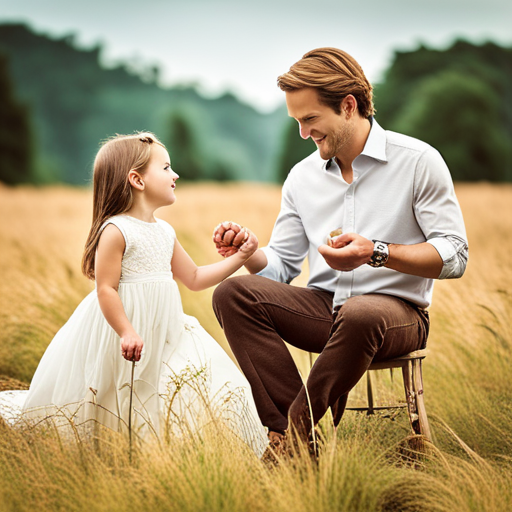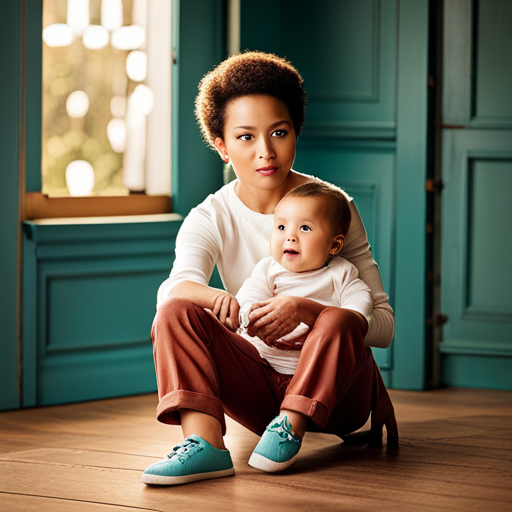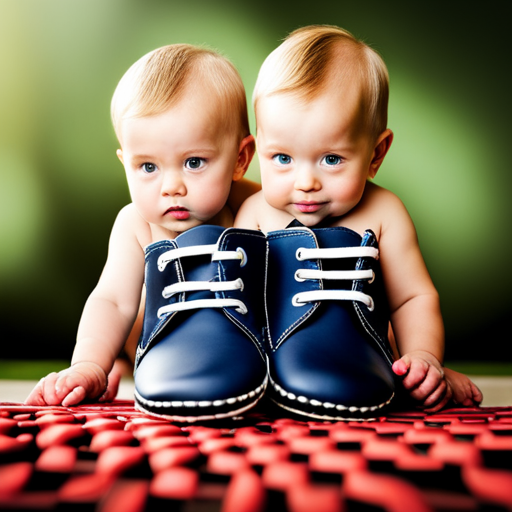"Cherishing Little Steps - A Haven for Baby and Family Journeys"
Baby Shoes 3-6 Months
Discover the perfect pair of shoes for your little one with our comprehensive guide to baby shoes for 3-6 months.
As parents, we understand the importance of finding shoes that not only fit properly but also ensure the utmost comfort and safety for your baby’s delicate feet.
In this article, we will explore the different types of shoes, share essential tips for choosing the right size and material, and provide recommendations for the best brands.
Let us help you navigate the world of baby shoes with confidence and peace of mind.
Key Takeaways
- Soft-soled booties, Velcro sneakers, leather moccasins, and high-top styles are suitable types of shoes for 3-6 month olds.
- Choose shoes with ankle support or high-top styles, and opt for shoes with Velcro or snap closures to help keep baby shoes on.
- Proper shoe sizing is important for comfort and healthy foot development. Regularly measure your baby’s feet as their size can change quickly.
- Leather, canvas, and synthetic materials are common choices for baby shoes. Consider the baby’s comfort, safety, and durability when choosing the right material.
Types of Shoes for 3-6 Month Olds

When considering the types of shoes for 3-6 month olds, it is important to prioritize comfort and support for their delicate developing feet. At this stage, babies begin to explore their surroundings by kicking and moving their legs, so their shoes should provide enough flexibility to support their natural foot movements.
When choosing the right style for baby shoes, opt for soft-soled shoes made from breathable materials like cotton or leather. Soft-soled shoes allow babies to feel the ground beneath them and promote healthy foot development. Look for shoes with a wide toe box to allow room for toes to wiggle and grow. Additionally, adjustable straps or elastic closures can ensure a secure fit without restricting movement.
However, even with the right style of shoes, keeping them on can be a challenge. Here are a few tips for keeping baby shoes on:
- Choose shoes with ankle support or high-top styles that help keep the shoes in place.
- Opt for shoes with Velcro or snap closures instead of laces, as they are easier to fasten and adjust.
- Consider using socks that have built-in elastic bands or ankle cuffs to help keep the shoes on.
- Regularly check the fit of the shoes and adjust them as needed to accommodate your baby’s growing feet.
Importance of Proper Shoe Sizing

The importance of proper shoe sizing cannot be overstated when it comes to ensuring the comfort and healthy development of your baby’s feet. Proper shoe fitting is crucial during the early stages of a baby’s life, as their feet are still growing and developing. Common shoe sizing mistakes can lead to a variety of issues, including discomfort, foot deformities, and hindered mobility.
One of the most common mistakes parents make is buying shoes that are too big, thinking that their baby will grow into them. However, this can lead to instability and discomfort for their little feet. On the other hand, buying shoes that are too small can cause pressure points, restrict movement, and even lead to foot deformities such as bunions or hammertoes.
To ensure proper shoe fitting, it is important to measure your baby’s feet regularly, as their size can change quickly during the first year of life. Look for shoes that have a wide toe box to allow for natural growth and movement of the toes. Additionally, choose shoes with flexible soles that provide support without restricting the natural movement of the foot.
Choosing the Right Material for Baby Shoes

One important factor to consider when choosing the right material for baby shoes is the breathability of the fabric, as it plays a crucial role in preventing moisture buildup and keeping the baby’s feet dry and comfortable. Babies have delicate and sensitive skin, so it is essential to choose materials that are gentle and safe for their little feet.
Here are some pros and cons of different shoe materials to help you make an informed decision:
-
Leather: Leather is a popular choice for baby shoes due to its durability and breathability. It allows air circulation, keeping the feet cool and dry. However, genuine leather can be expensive and requires proper care to prevent cracking and drying out.
-
Canvas: Canvas shoes are lightweight and flexible, making them ideal for babies who are learning to walk. They are also breathable and easy to clean. However, they may not provide as much support and protection as other materials.
-
Synthetic materials: Synthetic materials, such as nylon or polyester, are often used in baby shoes. They are affordable and easy to clean. However, they may not be as breathable as natural materials, leading to moisture buildup.
When choosing the right material for baby shoes, it is important to consider the baby’s comfort, safety, and the durability of the shoes.
Best Brands for 3-6 Month Old Baby Shoes

Some popular brands for 3-6 month old baby shoes include Nike and Stride Rite, which offer a wide range of styles and sizes to suit every baby’s needs. When it comes to baby shoe trends, comfort and support are key factors to consider. Both Nike and Stride Rite prioritize these elements in their designs, ensuring that little feet are well taken care of.
Nike, known for its athletic footwear, offers a variety of styles that are not only stylish but also provide the necessary support for growing feet. From soft-soled booties to flexible sneakers, Nike has options that cater to different developmental stages.
Stride Rite, on the other hand, specializes in children’s footwear and has been a trusted brand for many years. Their shoes are designed with the understanding of how babies’ feet grow and develop. Stride Rite offers a range of sizes and widths, allowing parents to find the perfect fit for their little ones.
In terms of popular shoe colors for babies, neutral tones such as gray, white, and beige are currently trending. These colors are versatile and can be easily paired with any outfit. Additionally, pastel hues like light pink, baby blue, and mint green are also popular choices for baby shoes, adding a touch of sweetness to their tiny feet.
When choosing baby shoes, it is important to prioritize comfort, support, and proper fit. Brands like Nike and Stride Rite not only offer stylish options but also provide the necessary features to support healthy foot development in babies aged 3-6 months.
How to Measure Your Baby’s Feet for Shoes

To ensure a proper fit, measure your baby’s feet carefully and accurately before purchasing shoes for them. Properly fitting shoes are crucial for the development and comfort of your baby’s feet. Here are some steps to help you measure your baby’s feet accurately:
-
Use a soft measuring tape: Use a soft measuring tape to measure the length of your baby’s foot. Make sure the tape is not too tight or loose.
-
Measure both feet: It is common for one foot to be slightly larger than the other. Measure both feet and use the larger measurement as a reference.
-
Consider growth room: Babies’ feet grow rapidly, so it is important to leave some room for growth. Experts recommend leaving about half an inch of space between the end of the shoe and your baby’s toes.
Finding the right fit for your baby’s shoes is essential for their comfort and proper development. Ill-fitting shoes can cause discomfort, hinder natural foot movement, and even lead to foot problems later in life. By measuring your baby’s feet accurately and considering growth room, you can ensure that their shoes fit properly and provide the necessary support and comfort.
Tips for Ensuring Baby’s Comfort in Shoes

When selecting shoes for your baby, it is important to prioritize their comfort to ensure their little feet are properly supported at all times. Baby shoe styles have evolved over the years to accommodate the delicate needs of growing feet. It is crucial to consider the common foot issues in babies, such as flat feet, pronation, and toe-walking, when choosing the right shoes.
When it comes to baby shoe styles, opt for soft-soled shoes made from breathable materials to promote natural foot movement and prevent excessive sweating. Look for shoes with flexible soles that mimic barefoot walking, allowing your baby’s feet to develop naturally. Additionally, choose shoes with adjustable closures, such as Velcro or elastic, to ensure a snug fit and easy on/off.
To ensure your baby’s comfort, always measure their feet accurately and choose the appropriate size. Remember that babies’ feet grow quickly, so regular measurements are essential. Avoid shoes that are too tight or too loose, as they can cause discomfort and hinder proper foot development.
Regularly inspect your baby’s shoes for any signs of wear or damage. Replace them as needed to maintain their comfort and support. Investing in quality shoes that prioritize your baby’s comfort will help prevent foot issues and promote healthy foot development.
Always consult with a pediatrician or a podiatrist if you have any concerns about your baby’s foot health.
Safety Considerations for Baby Shoes

Three key safety considerations for baby shoes include the quality of materials used, proper fit, and the absence of potential choking hazards. When it comes to choosing baby shoes, it is essential to prioritize safety to ensure the well-being of little ones.
First and foremost, the quality of materials used in baby shoes is crucial. Opt for shoes made from breathable and soft materials, such as leather or fabric, to promote comfort and prevent irritation on delicate baby skin. Avoid shoes with sharp edges or loose parts that could potentially harm the baby.
Proper fit is another vital safety consideration. Ill-fitting shoes can cause discomfort and potentially lead to common foot problems in babies, such as blisters or ingrown toenails. It is advisable to refer to a reliable baby shoe size chart to ensure an accurate fit. Remember that babies’ feet grow rapidly, so regular measurements are necessary to ensure the shoes fit properly.
Lastly, check for potential choking hazards in baby shoes. Avoid shoes with small decorative elements, buttons, or detachable parts that could become detached and pose a choking risk. Shoes with Velcro or elastic closures are preferable over those with laces, as they reduce the risk of tripping or getting entangled.
When to Start Putting Shoes on Your Baby

Parents should consider the developmental milestones and foot growth patterns of their baby before making the decision to introduce shoes. Choosing the right size and considering safety considerations are crucial elements in this decision-making process.
In the first few months of a baby’s life, their feet are still developing and growing rapidly. It is recommended to allow babies to be barefoot as much as possible during this time, as it allows their feet to naturally develop and strengthen. However, as babies start to explore their surroundings and become more mobile, parents may consider introducing shoes to protect their little one’s feet.
When choosing baby shoes, it is important to ensure the shoes are the right size. Ill-fitting shoes can hinder proper foot development and may cause discomfort or pain for the baby. It is recommended to measure the baby’s feet regularly and consult a sizing chart to ensure an accurate fit.
Safety considerations should also be taken into account when selecting baby shoes. Look for shoes with non-slip soles to provide traction and prevent falls. Additionally, choose shoes made from breathable materials to reduce the risk of overheating and sweating.
Benefits of Soft-Soled Shoes for 3-6 Month Olds

Soft-soled shoes provide comfort and support while aiding in the proper development of 3-6 month olds’ growing feet. These shoes offer a range of benefits that every parent should consider when choosing footwear for their little ones.
Here are three key benefits of soft-soled shoes:
-
Promotes natural foot development: Soft-soled shoes allow babies’ feet to move and flex naturally, promoting the development of their muscles and bones. This is crucial during the early stages of walking as it helps to strengthen their feet and improve balance.
-
Provides sensory stimulation: Soft-soled shoes allow babies to feel the ground beneath their feet, providing sensory feedback that helps with their overall development. The soft, flexible soles ensure that little feet can feel different surfaces and textures, enhancing their sensory experience.
-
Offers comfort and protection: Soft-soled shoes are designed with the delicate feet of babies in mind. They provide a gentle and cushioned support, protecting their feet from potential hazards while ensuring maximum comfort throughout the day.
When it comes to choosing the right soft-soled shoes for your baby, there are various types to consider. From simple slip-on styles to those with adjustable straps, you can find a wide range of options that suit your baby’s needs and style. Remember to choose shoes that are made of breathable materials and have a non-slip sole for added safety.
How to Clean and Care for Baby Shoes

When it comes to keeping baby shoes in pristine condition, it is important to regularly clean them with a gentle detergent and store them in a dry, well-ventilated area to prevent any potential damage or odors. Cleaning techniques for baby shoes vary depending on the material they are made of. For fabric shoes, it is best to hand wash them using a mild detergent and then air dry them. Leather shoes can be wiped clean with a damp cloth and then conditioned with a leather conditioner to maintain their softness and prevent cracking. For shoes with rubber soles, a mixture of water and mild soap can be used to remove any dirt or stains.
In addition to proper cleaning techniques, choosing the right shoe storage options is equally important. Here is a table that outlines three popular shoe storage options for baby shoes:
| Storage Option | Description | Benefits |
|---|---|---|
| Shoe Rack | A rack with multiple tiers to neatly store shoes | Saves space and allows easy access to shoes |
| Hanging Organizer | A fabric organizer with pockets that can be hung on a door or wall | Maximizes vertical space and keeps shoes organized |
| Shoe Box | Clear plastic boxes that can be stacked and labeled | Protects shoes from dust and allows for easy identification |
Frequently Asked Questions
Are Baby Shoes Necessary for 3-6 Month Olds?
Baby shoes may not be necessary for 3-6 month olds. It is crucial to consider the baby’s shoe size guide and the benefits of barefoot walking. Expert advice can help parents make informed decisions.
Can I Use Hand-Me-Down Shoes for My Baby?
Hand-me-down shoes for babies can be a cost-effective option, but it is important to consider the pros and cons. While they may save money, they may not fit properly or provide adequate support, potentially leading to discomfort or foot problems.
What Are the Signs That My Baby’s Shoes Are Too Tight?
Signs of tight baby shoes include redness, blisters, and difficulty moving toes. To choose the right size, measure baby’s feet regularly and opt for soft, flexible shoes with room to grow. Properly fitted shoes promote healthy foot development and ensure comfort for your little one.
How Often Should I Measure My Baby’s Feet for New Shoes?
When it comes to choosing the right size baby shoes, it is important to regularly measure your baby’s feet. This ensures that they are wearing shoes that fit properly and allows for healthy foot development.
Are There Any Specific Safety Features I Should Look for in Baby Shoes for 3-6 Month Olds?
When considering safety features for baby shoes, it is important to prioritize materials that are breathable, flexible, and non-slip to ensure proper foot development and prevent accidents.
Conclusion
In conclusion, choosing the right shoes for 3-6 month olds is crucial for their comfort and development.
Proper sizing, material selection, and brand reliability are important factors to consider.
Soft-soled shoes provide numerous benefits for this age group.
Additionally, regular cleaning and care will ensure the longevity of the baby shoes.
By following these guidelines, parents can provide their little ones with safe and comfortable footwear that supports healthy growth and development.


